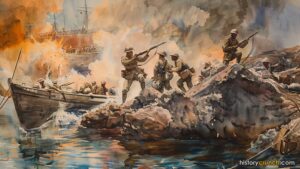The Dunkirk Evacuation, which was also known as ‘Operation Dynamo’, was a dramatic Allied military retreat that occurred during the early stages of World War II. It occurred between May 26th and June 4th, 1940, and saw 335,000 Allied soldiers (British and French) rescued from the beaches of Dunkirk, which is a port town in northern France. At the time, Nazi German forces were advancing and surrounding the Allied forces in Dunkirk. Though it was a retreat, the Dunkirk Evacuation is often remembered in Britain as an example of resilience, resourcefulness, and national unity.
DUNKIRK EVACUATION – BACKGROUND
As stated above, the Dunkirk Evacuation was a significant event at the beginning of World War II. As such, it’s important to understand the outbreak of the war. World War II began when Nazi Germany invaded Poland on September 1st, 1939. In fact, Britain and France declared war on Nazi Germany just two days later, on September 3rd.
Next, Britain sent the British Expeditionary Force (BEF) to France to help defend the country from a potential Nazi Germany attack. In fact, much of the trench warfare of World War I had occurred along the eastern regions of France, and military leaders in the late 1930s, were expecting a very similar conflict. After a brief period where no little actual occurred, known as the ‘Phoney War’, Germany began its attack against France and Belgium through the Ardennes Forest.
France was not anticipating a German attack through the Ardennes, believing that the forest was too thick for tanks, and other heavy machinery, to mobilize through. Instead, French authorities believed that Germany would attack along the France-Germany border where France had built the defensive Maginot Line. Or, they believed that Nazi Germany would advance through Belgium to the north, which would allow time for British and French forces to mobilize in that area. Instead, German tank division were able to push through the Ardennes Forest with relative ease and surprised the British and French. This surprise maneuver and the speed in which the Nazi German forces advanced was the primary cause of the need for the Dunkirk Evacuation.
In fact, the Nazi German army moved with incredible speed, which is referred to as ‘blitzkrieg’. The term ‘blitzkrieg’ refers to the speed and overwhelming force of the Nazi Germany Army, and historians have used the phrase ‘lightning war’ in reference to the Nazi German blitzkrieg tactics.
DUNKIRK EVACUATION – SUMMARY
As stated previously, the retreat at Dunkirk took place between May 26th and June 4th 1940, as German forces were attacking Belgium and France as part of the Battle of France. The retreat at Dunkirk involved large numbers of British and French soldiers retreating mainland Europe to the British Isles after Nazi German forces overwhelmed them and cut them off from the rest of the Allied forces in France.
As the German tank divisions pushed through into France, they circled north and raced to the English Channel. This maneuver cut off the British Expeditionary Force and other French soldiers from the rest of the army and they were threatened with losing hundreds of thousands of soldiers to the successful and rapid Nazi German assault. In fact, by late May, hundreds of thousands of Allied soldiers were trapped near Dunkirk, with their backs to the sea and the German army closing in. British Prime Minister Winston Churchill referred to the crisis as “a colossal military disaster” and that Britain was in danger of losing a substantial portion of its forces.
In response, the British scrambled to evacuate the British Expeditionary Force from the harbor city of Dunkirk, France. The plan, codenamed ‘Operation Dynamo’ was an emergency evacuation plan created by Vice Admiral Bertram Ramsay. From May 28th to the 31st, approximately 40,000 French soldiers stood up against the Nazi German assault, delaying the German advance and allowing the British Expeditionary Force to build defensive structures and form a plan of retreat across the English Channel, back to Britain. Over the course of the next 8 days over 335,000 soldiers of the British Expeditionary Force were able to flee France and return to Britain. They made the retreat aboard over 800 boats, including military vessels and a fleet of small merchant ships, such as: fishing boats, shipping boats and pleasure ships. Many smaller British ships made the journey across the English Channel to help rescue the trapped British forces and to flee the German push through Belgium and France. The evacuation was carried out under intense pressure from German air and artillery attacks.
DUNKIRK EVACUATION – SIGNIFICANCE
In the end, the retreat at Dunkirk was vital to the eventual success of the Allied armies. The rescued British and French soldiers would later play a critical role in the Battle of Britain and the Normandy Invasion, which were important Allied victories in the later years of World War II. If the British had lost their entire British Expeditionary Force at Dunkirk, they may not have had the ability to help liberate France and bring an end to Nazi Germany. It led directly to the Battle of Britain, where the Royal Air Force successfully defended Britain against Nazi German air attacks.
The Dunkirk Evacuation was also an important moral victory for the Allies and brought a source of pride to the British public in a time of fear and uncertainty. For instance, British Prime Minister Winston Churchill, in his famous June 4th speech, cautioned that “wars are not won by evacuations” but nonetheless praised the operation as a symbol of courage. In fact, the event became known as the ‘Miracle of Dunkirk’ in British media, and was a source of national unity for Britain.


